americans
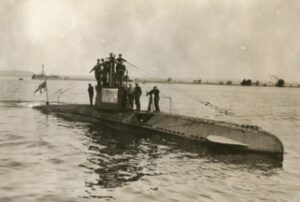 When a nation has a weapon that is so deadly to its enemy nations, those nations have no choice but to find a new way to beat that weapon. The German U-Boat was just such a weapon. Gliding along silently beneath the sea, the U-Boat put the ships of the Allied nations in constant and grave danger. That was one of the reasons that the British developed a fixation on their presence at sea. They depended on seaborne trade, and during World War I, the Germans were terrorizing that trade.
When a nation has a weapon that is so deadly to its enemy nations, those nations have no choice but to find a new way to beat that weapon. The German U-Boat was just such a weapon. Gliding along silently beneath the sea, the U-Boat put the ships of the Allied nations in constant and grave danger. That was one of the reasons that the British developed a fixation on their presence at sea. They depended on seaborne trade, and during World War I, the Germans were terrorizing that trade.
For much of Great Britain’s history, they enjoyed the luxury of having more battleships than the next two powers combined. For that reason, the Germans knew that they would have to concentrate their efforts on attacking vulnerable shipping lanes to disrupt the British war effort. They didn’t care if there were passengers on those ships. They didn’t care about loss of life or supplies. They had one plan…to dominate the seas. German submarines became a menace to the merchant navy. Something had to change, so the British came up with a plan to counter the U-boat threat. The plan involved disguising armed vessels as harmless trawlers to 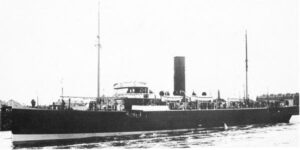 lure the submarines in and then wipe them out. The answer to the U-boat were disguised vessels…decoys, known as Q-ships.
lure the submarines in and then wipe them out. The answer to the U-boat were disguised vessels…decoys, known as Q-ships.
Knowing that the U-Boats were under orders to attack just about anything. The Q-ships hid naval guns behind pivoting panels. It was the Sun Tzu tenet of “hold out baits to entice the enemy.” The Q-ships pretended to be disabled and when the U-Boats show up for the kill, the Q-ships went into action. Guns and additional crew had been concealed by hinges that could be dropped at a moment’s notice. The U-boats of World War I had limited range and carrying capacity, so the captains were nervous about wasting their torpedoes. Also, while the U-Boats of World War II were more capable of lang periods of time submerged, the U-Boats of World War I, had limited capability, so they preferred to use the submarine’s main gun to subdue ships whenever possible.
As the U-Boats came into sight of the Q-ship, the Q-ship’s crew would pretend to panic and abandon the ship to  draw the submarine in close. The U-Boats, once lured in, were at the mercy of the Q-ships. The Q-ships began to drop their depth charges as soon as the submarine tried to escape. It was a dangerous game to play and required a brave crew to pull off the ruse, and it was not always successful. Some Q-ships were lost, but because of their efforts the threat of submarines in World War I were lessened. The plan was to try the tactic again in World War II, but ships were in very short supply. The tactic of using decoy ships was much more limited but was also used by the Germans and Americans. While it wasn’t a major tactical warfare practice during the two wars, it was effective while it was used.
draw the submarine in close. The U-Boats, once lured in, were at the mercy of the Q-ships. The Q-ships began to drop their depth charges as soon as the submarine tried to escape. It was a dangerous game to play and required a brave crew to pull off the ruse, and it was not always successful. Some Q-ships were lost, but because of their efforts the threat of submarines in World War I were lessened. The plan was to try the tactic again in World War II, but ships were in very short supply. The tactic of using decoy ships was much more limited but was also used by the Germans and Americans. While it wasn’t a major tactical warfare practice during the two wars, it was effective while it was used.

 As we come to a close in the year 2021, I think most of us would agree that this was one tough year, but then again, not as bad as 2020. So many things are in total disarray, and most people are unhappy with the direction our country is headed. Nevertheless, as Americans, we are ever hopeful for the future. It’s just in our nature. We are looking to the future of elections, times after Covid, and times when thing can get back to normal.
As we come to a close in the year 2021, I think most of us would agree that this was one tough year, but then again, not as bad as 2020. So many things are in total disarray, and most people are unhappy with the direction our country is headed. Nevertheless, as Americans, we are ever hopeful for the future. It’s just in our nature. We are looking to the future of elections, times after Covid, and times when thing can get back to normal.
While this has been a tough year, it has also been a year of fire. I suppose that could sound odd, but everyone has had to make their own decisions about things like school, health, jobs, and church. Some of these decisions were very difficult, and it felt like being thrown into the fire. Many have found themselves in trouble with everyone from family to Facebook. Posts have been deleted and friends have chosen to unfriend us…and yet, we stand. We must stand…or we will never be able to stand again. If we fail to use te freedoms and rights that belong to us, they might just be taken away from us. There just comes a time when you must choose to fight for what you believe in. And then there were the forest fires, the December tornadoes, the earthquakes in odd places, and the volcanoes…including a brand new one in Iceland. Things are getting pretty wild around here.
This has been a hard year. We have lost loved ones and friends, and yet we have learned to stand strong. We have comforted those who have lost loved ones. Helped those in quarantine. We have delivered groceries, meds, and meals. In essence, we have become good neighbors in the face of all the riots and hate. We have proven that we, as Americans will continue to be America-Strong. Yes, I think we are all ready to say goodbye 
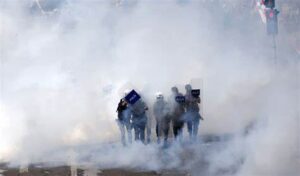 to 2021, and very ready to bring in 2022. I suppose that is because no matter how bad this year has been, we know that much has changed in a good way. Many things have been exposed and will continue to be exposed. What has been hidden is coming to light and will continue to do so. I really expect the year 2022 to be an amazing year, full of promise, and I am looking forward to what is to come. Tonight, I encourage you to stay hopeful and prepare for great days ahead.
to 2021, and very ready to bring in 2022. I suppose that is because no matter how bad this year has been, we know that much has changed in a good way. Many things have been exposed and will continue to be exposed. What has been hidden is coming to light and will continue to do so. I really expect the year 2022 to be an amazing year, full of promise, and I am looking forward to what is to come. Tonight, I encourage you to stay hopeful and prepare for great days ahead.
 Every four years, Americans go to the polls to elect a new president. Looking at the first time that a president is elected, quite often, we know little about the person running for president. Even if they have been in Congress, it takes some digging to really discover who they are, and what they can do for our nation. We rely on things like the political party they belong to or the campaign promises they make. Still, we have no idea what the candidate will really do, until they are in office.
Every four years, Americans go to the polls to elect a new president. Looking at the first time that a president is elected, quite often, we know little about the person running for president. Even if they have been in Congress, it takes some digging to really discover who they are, and what they can do for our nation. We rely on things like the political party they belong to or the campaign promises they make. Still, we have no idea what the candidate will really do, until they are in office.
Sometimes, there are exceptions to that basic rule, however. Such was the case with Dwight D Eisenhower, who was the supreme commander of Allied forces in Western Europe during World War II. Of course, running a nation is not the same as running a war, unless the nation happens to be at war, that is. Nevertheless, a commander who excelled at leading a war, was by definition, a leader…making it a good bet that he could also lead a nation. Eisenhower was that kind of leader, and the people of the United States could see it clearly. He led the massive invasion of Nazi-occupied Europe that began on D-Day…June 6, 1944. Then in 1952, with victory under his belt, leading Republicans convinced Eisenhower, who by then was in command of NATO forces in Europe, to run for president. As the campaign progressed, it would remain to be seen, just how much the people of the United States thought that he would make a good leader for the nation. The election would be the telling point.
And so it went. Eisenhower won a convincing victory over Democrat Adlai Stevenson and would serve two terms in the White House (1953-1961). Even more amazing than his victory was the fact that General Dwight D Eisenhower won the American presidential elections with the largest number of popular votes ever recorded for a presidential candidate. It was a landslide victory. The people had spoken. Also of note, is that Eisenhower was the only other president to win the presidential election, having never served in any other political office. I’m sure everyone knows that the other president to do that is our current president…Donald Trump. That is an almost unheard of feat. A general and a businessman, both of whom had not been politically inclined, and yet, here they were. During his presidency, Eisenhower managed Cold War-era tensions with the Soviet Union under the looming threat of nuclear weapons, ended the war in Korea in 1953 and authorized a number of covert anti-communist operations by the CIA around the world. Here at home, America was in a period of relative prosperity, nevertheless, Eisenhower strengthened Social Security and created the massive new Interstate Highway System. Eisenhower was so well liked that he would beat Stevenson again four years later in a landslide to win re-election, despite health concerns after suffering a heart attack in 1955.
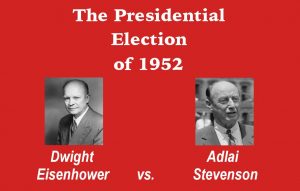
Eisenhower was born in Denison, Texas, on October 14, 1890. He grew up in Abilene, Kansas, as the third of seven sons in a poor family. His mother, a devout Mennonite and pacifist, was quite distressed when young Ike…as he was known…won an appointment to the US Military Academy at West Point, New York. Nevertheless, he went on to graduate in the middle of his class in 1915. While stationed as a second lieutenant in San Antonio, Texas, Eisenhower met Mamie Geneva Doud. The couple married in 1916 and had two sons, Doud Dwight, who died of scarlet fever as a small child, and John. World War I ended just before Eisenhower was scheduled to go to Europe, which was frustrating to the young officer, but he soon managed to acquire an appointment to the Command and General Staff College at Fort Leavenworth, Kansas. Graduating first in his class of 245, he served as a military aide to General John J Pershing, commander of US forces during World War I, and later to General Douglas MacArthur, US Army chief of staff. During his seven years serving under MacArthur, Eisenhower was stationed in the Philippines from 1935 to 1939.
Eisenhower returned soon after Nazi Germany’s invasion of Poland sparked the outbreak of World War II in Europe. In September 1941, he received his first general’s star with a promotion to brigadier general. After Japan attacked Pearl Harbor that December, US Army Chief of Staff General George C Marshall called Eisenhower to Washington, DC to work as a planning officer. Beginning in November 1942, Eisenhower headed Operation Torch, the successful Allied invasion of North Africa. He then directed the amphibious invasion of Sicily and the Italian mainland in 1943 that led to the fall of Rome in June 1944. In early 1943, he was made a full general. Eisenhower was appointed supreme commander of the Allied Expeditionary Force in December of that year and given the responsibility of spearheading the planned Allied invasion of Nazi-occupied Europe. On D-Day…June 6, 1944, more than 150,000 Allied forces crossed the English Channel and stormed the beaches of Normandy. The invasion led to the liberation of Paris on August 25 and turned the tide of the war in Europe decisively in the Allied direction. Having risen from lieutenant colonel in the Philippines to supreme commander of the victorious forces in Europe in only five years, Eisenhower returned home to a hero’s welcome in 1945 to serve as chief of staff of the US Army.
In 1948, Eisenhower left active duty and became president of New York City’s Columbia University. His brief 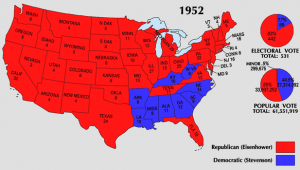 return to civilian life ended in 1950, however, when President Harry S Truman asked him to take command of the new North Atlantic Treaty Organization (NATO) forces in Europe. In that position, Eisenhower worked to create a unified military organization that would combat potential communist aggression around the globe. As President of the United States, while weathering criticism from both left and right, Eisenhower enjoyed high approval ratings throughout his administration. After leaving office in January 1961, he retired to his farm in Gettysburg, Pennsylvania. He worked largely on his memoirs, and would publish several books over the following years. He died on March 28, 1969, after a long illness.
return to civilian life ended in 1950, however, when President Harry S Truman asked him to take command of the new North Atlantic Treaty Organization (NATO) forces in Europe. In that position, Eisenhower worked to create a unified military organization that would combat potential communist aggression around the globe. As President of the United States, while weathering criticism from both left and right, Eisenhower enjoyed high approval ratings throughout his administration. After leaving office in January 1961, he retired to his farm in Gettysburg, Pennsylvania. He worked largely on his memoirs, and would publish several books over the following years. He died on March 28, 1969, after a long illness.
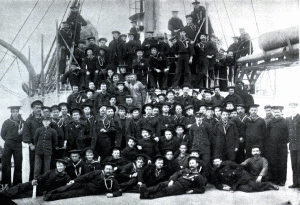 One of the first American battleships, the USS Maine weighed more than 6,000 tons and was built at a cost of more than $2 million. That was a lot of money back in 1884, when the USS Maine, several other new battleships, and other warships built by the United States Navy to modernize the fleet. The Maine was launched on November 18, 1889, and commissioned on September 17, 1895.
One of the first American battleships, the USS Maine weighed more than 6,000 tons and was built at a cost of more than $2 million. That was a lot of money back in 1884, when the USS Maine, several other new battleships, and other warships built by the United States Navy to modernize the fleet. The Maine was launched on November 18, 1889, and commissioned on September 17, 1895.
The ship was sent to Cuba on a friendly visit to protect the interests of Americans there after a rebellion against Spanish rule broke out in Havana in January, 1898. On February 15, 1898, while sitting in Cuba’s Havana harbor, the ship suddenly exploded, killing 260 of the fewer than 400 American crewmen onboard. The massive explosion of unknown origin, was the subject of an official U.S. Naval 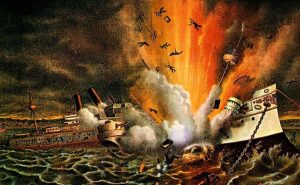 Court of Inquiry, which ruled in March that the ship was blown up by a mine, without directly placing the blame on Spain. The majority of Congressmen and of the American public felt that there was little doubt that Spain was responsible and they called for a declaration of war.
Court of Inquiry, which ruled in March that the ship was blown up by a mine, without directly placing the blame on Spain. The majority of Congressmen and of the American public felt that there was little doubt that Spain was responsible and they called for a declaration of war.
Diplomatic failures to resolve the USS Maine explosion, in addition to the indignation the United States felt over Spain’s brutal suppression of the Cuban rebellion and continued losses to American investment, led to the outbreak of the Spanish-American War in April 1898. The destruction of USS Maine and the loss of life that accompanied it, played a large part in the beginning of that war. As we have seen in history both before and after this incident, waking the sleeping giant that is the United States is never a good idea. We may be slow to enter a war, but when we get into one, we go into it full bore. When this giant goes to war, we go to win.
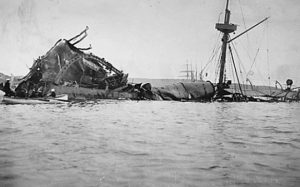
It took the United States only three months to decisively defeat the Spanish forces on land and sea. In August an armistice halted the fighting. On December 12, 1898, the Treaty of Paris was signed between the United States and Spain, officially ending the Spanish-American War and granting the United States its first overseas empire with the ceding of such former Spanish possessions as Puerto Rico, Guam, and the Philippines. In 1976, a team of American naval investigators concluded that the Maine explosion was likely caused by a fire that ignited its ammunition stocks, not by a Spanish mine or act of sabotage. I guess we will never know for sure.
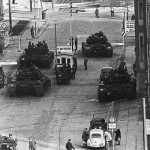 It seems there is always talk of the Third World War coming, and what might set it off. Most people hope that it stays all talk, because the weapons that are available these days could potentially wipe the human race off the planet, or at the very least, wipe whole nations off the map. Sometimes I wonder how we have avoided it so far, considering all the hate in the world today. Somehow our world leaders have held it off…for now. Nevertheless, there have been times when we have come very close to the last straw that would bring World War III. For 16 hours, between October 27 and October 28, 1961, at the height of the Cold War, US and Soviet tanks faced each other in divided Berlin in an action that brought the two superpowers closer to kicking off a third world war than in any other cold-war confrontation, with the exception of the Cuban missile crisis one year later. It was a very heated time in history.
It seems there is always talk of the Third World War coming, and what might set it off. Most people hope that it stays all talk, because the weapons that are available these days could potentially wipe the human race off the planet, or at the very least, wipe whole nations off the map. Sometimes I wonder how we have avoided it so far, considering all the hate in the world today. Somehow our world leaders have held it off…for now. Nevertheless, there have been times when we have come very close to the last straw that would bring World War III. For 16 hours, between October 27 and October 28, 1961, at the height of the Cold War, US and Soviet tanks faced each other in divided Berlin in an action that brought the two superpowers closer to kicking off a third world war than in any other cold-war confrontation, with the exception of the Cuban missile crisis one year later. It was a very heated time in history.
Washington and its British and French allies had failed to stop the Russians from building the Berlin Wall in August of 1961. By October, East German officials began to deny US diplomats the unhindered access to East Berlin that they were required to allow as part of the agreement with Moscow on the postwar occupation of Germany. Then, on 22 October, E Allan Lightner Jr, the senior US diplomat in West Berlin, was stopped by East German border guards on his way to the state opera house in East Berlin. The East Germans demanded to see his passport, which he insisted only Soviet officials had the right to check. The situation grew more heated with this exchange. Lightner was forced to turn back.
General Clay, who was an American hero of the 1948-1949 Berlin Airlift was sent by Washington to deal with the Russians after the erection of the Berlin Wall. He gave orders that the next American diplomat entering East Berlin be escorted by armed US army military police in jeeps. The maneuver succeeded, but the East Germans continued to attempt to assert their claim to control western allied officials entering East Berlin. Never one to suffer defeat easily, Clay ordered American M48 tanks to head for Checkpoint Charlie. There they stood, some 80 yards from the border, noisily racing their engines and sending plumes of black smoke into the night air. Alarmed by the apparent threat, Moscow, with the approval of the Soviet leader, Nikita Khrushchev, sent an equal number of Russian T55 tanks rumbling to face down the Americans. They too ground to a halt some 80 yards from the East/West Berlin border and, as with the US tanks they faced, stayed there for 16 hours.
American officials were becoming more and more alarmed by the potential consequences. General Clay was quickly reminded by Washington that Berlin was not so “vital” an interest to be worth risking a conflict with Moscow. President Kennedy approved the opening of a back channel with the Kremlin in order to defuse the situation that had blown up. As a result, the Soviets pulled back one of their T55s from the eastern side of the border at Friedrichstrasse and minutes later an American M48 also left the scene. That was how it went until all the tanks were withdrawn. General Clay’s reputation among West Berliners rose, but not so much his warrior capabilities as far as the united States was concerned. Khrushchev had been equally uninterested in risking a 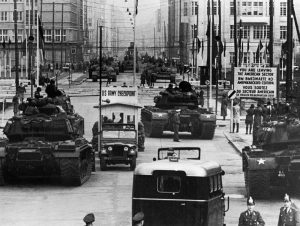 battle over Berlin. In return for Kennedy’s assurance that the west had no designs on East Berlin, the Soviet leader tacitly recognised that allied officials and military personnel would have unimpeded access to the East German capital. From that point on, the western allies freely dispatched diplomats and military personnel to attend the opera and theater in East Berlin. Soviet diplomats, too, attended functions in West Berlin and sent Volga limousines packed with Soviet military police on patrol to West Berlin. The elaborate routine served to prove that the Four Power status of the city was intact. It was faithfully observed until the Wall fell in 1990. they weren’t as eager to start World War III as they thoughts they were.
battle over Berlin. In return for Kennedy’s assurance that the west had no designs on East Berlin, the Soviet leader tacitly recognised that allied officials and military personnel would have unimpeded access to the East German capital. From that point on, the western allies freely dispatched diplomats and military personnel to attend the opera and theater in East Berlin. Soviet diplomats, too, attended functions in West Berlin and sent Volga limousines packed with Soviet military police on patrol to West Berlin. The elaborate routine served to prove that the Four Power status of the city was intact. It was faithfully observed until the Wall fell in 1990. they weren’t as eager to start World War III as they thoughts they were.
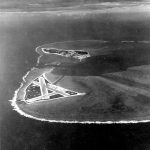 It’s a tiny island in the middle of the vast Pacific Ocean, so what possible impact could a battle for control of Midway Island have had? The answer is…much more than you might think. Sometimes, it’s not about the size of the nation, but rather about the might of its army. Japan is a little nation, it had built a mighty army and it was systematically defeating the Allies. Although other battles would soon make Midway seem like a small battle, no naval battle of World War II…and few others, if any, in all of naval history…would have so many momentous consequences ascribed to it as this one battle. So complete was Japan’s defeat at Midway, and so stunned was the Imperial High Command, that it would keep the results of the battle a secret from the Japanese people for the rest of the World War II.
It’s a tiny island in the middle of the vast Pacific Ocean, so what possible impact could a battle for control of Midway Island have had? The answer is…much more than you might think. Sometimes, it’s not about the size of the nation, but rather about the might of its army. Japan is a little nation, it had built a mighty army and it was systematically defeating the Allies. Although other battles would soon make Midway seem like a small battle, no naval battle of World War II…and few others, if any, in all of naval history…would have so many momentous consequences ascribed to it as this one battle. So complete was Japan’s defeat at Midway, and so stunned was the Imperial High Command, that it would keep the results of the battle a secret from the Japanese people for the rest of the World War II.
The story of the battle has been told many times over the years, and Midway continues to hold an almost mysterious place in the collective memory of the United States Navy and the United States in general. However, in recent decades a new generation of scholars has studied the facts of the battle. In some ways they 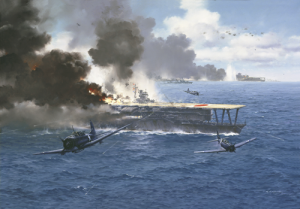 have removed the mystery of how such a “miracle” victory came to be and in other ways they have chalked it up to chance, luck, and the weather. The Americans had heard something about an attack, but the Japanese used the code location as “AF” to keep the attack location secret. The Americans suspected that it was Midway, so they sent a radio message that the island’s desalinization plant had broken down. The radio message was broadcast without encryption to ensure that Japan could read it if it was intercepted. The radio message was duly intercepted by Japan and reported by a message encoded in JN25 stating that AF’s desalinization plant was out of order and was intercepted by Station HYPO. “AF” was thus confirmed as Midway.
have removed the mystery of how such a “miracle” victory came to be and in other ways they have chalked it up to chance, luck, and the weather. The Americans had heard something about an attack, but the Japanese used the code location as “AF” to keep the attack location secret. The Americans suspected that it was Midway, so they sent a radio message that the island’s desalinization plant had broken down. The radio message was broadcast without encryption to ensure that Japan could read it if it was intercepted. The radio message was duly intercepted by Japan and reported by a message encoded in JN25 stating that AF’s desalinization plant was out of order and was intercepted by Station HYPO. “AF” was thus confirmed as Midway.
That was the beginning of the end for Japan. The Americans began to prepare for the attack. American scholars of Midway have long tried to explain away the many coincidences by characterizing the result of the battle as little short of a “miracle.” Walter Lord would name his 1967 narrative of Midway Incredible Victory, and 15 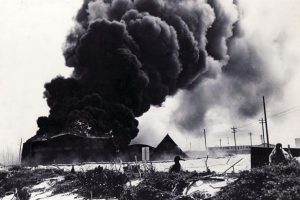 years later Gordon Prange’s posthumously published account of the battle was straightforwardly entitled Miracle at Midway. One battle participant’s memoir stated, “God was at Midway.” He saw divine intervention at work. The concept of the miracle has helped to explain the elements of the battle that have eluded detection, explication, or understanding. Some say that over the years, Midway has become less of a miracle, but that many mysteries remain. I say, that it was a miracle. God was at work at Midway. Even the weather worked against the Japanese when cloud cover prevented them from seeing what was right in front of them, and at the end of their attack…less than a week later, four Japanese fleet carriers would be twisted ruins on the bottom of the Pacific.
years later Gordon Prange’s posthumously published account of the battle was straightforwardly entitled Miracle at Midway. One battle participant’s memoir stated, “God was at Midway.” He saw divine intervention at work. The concept of the miracle has helped to explain the elements of the battle that have eluded detection, explication, or understanding. Some say that over the years, Midway has become less of a miracle, but that many mysteries remain. I say, that it was a miracle. God was at work at Midway. Even the weather worked against the Japanese when cloud cover prevented them from seeing what was right in front of them, and at the end of their attack…less than a week later, four Japanese fleet carriers would be twisted ruins on the bottom of the Pacific.
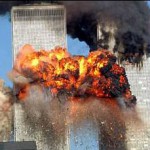 Fifteen years ago today, Americans were greeted with horror, as terrorism split the atmosphere of safety we had long enjoyed around our nation. I think most Americans had become comfortable, and even complacent about national security. Life was going along at almost a lazy Sunday afternoon pace. We were like small town kids, who thought that nothing ever happens in our town. How very wrong we were. Our world was about to be turned upside down.
Fifteen years ago today, Americans were greeted with horror, as terrorism split the atmosphere of safety we had long enjoyed around our nation. I think most Americans had become comfortable, and even complacent about national security. Life was going along at almost a lazy Sunday afternoon pace. We were like small town kids, who thought that nothing ever happens in our town. How very wrong we were. Our world was about to be turned upside down.
When the first plane hit the World Trade Center, I think most people thought it was a tragic accident. We simply couldn’t fathom the idea that a terrorist would be so horribly cruel as to hijack a plane full of innocent people and fly it straight into a building full of more innocent people. And yet, to our horror, that is exactly what these terrorists did. They operated the planes with no mercy and no feelings. They did not care about the lives they were taking or even about their own lives…in fact, they thought they were heroes for their actions, and that there would be great rewards in Heaven for them. Their complete shock as they entered Hell, must have been devastating.
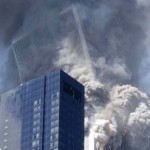 Their actions left our nation is shock and disbelief. We watch as the devastation unfolded before us, growing worse by the moment, our hearts and minds were assaulted, yet we could not look away. We watched, hoping that the people on the top floors could be saved…even after they began to fall or jump from the building, because the heat was more than they could take. We felt sick with each and every thud. We prayed over the rescuers, that they would be successful in getting people out, and that they would come out too. We watched in stunned disbelief as the towers fell, praying that after the first tower fell, that somehow, the second would remain standing…until it also fell. We became angry at the people who had done this, without provocation. Pure hate, of our beliefs, our prosperity, and our liberties, and that drove them to attack us.
Their actions left our nation is shock and disbelief. We watch as the devastation unfolded before us, growing worse by the moment, our hearts and minds were assaulted, yet we could not look away. We watched, hoping that the people on the top floors could be saved…even after they began to fall or jump from the building, because the heat was more than they could take. We felt sick with each and every thud. We prayed over the rescuers, that they would be successful in getting people out, and that they would come out too. We watched in stunned disbelief as the towers fell, praying that after the first tower fell, that somehow, the second would remain standing…until it also fell. We became angry at the people who had done this, without provocation. Pure hate, of our beliefs, our prosperity, and our liberties, and that drove them to attack us.
As the day went on, we watched in horror as more information came out. We knew that there were going to be 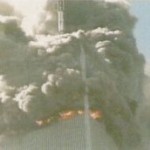 many people died, but still we watched as they dug through the rubble. We thought there would suddenly be people found alive in that rubble. As time went on, we knew that there wouldn’t be huge numbers of survivors. In the end, only twelve people were found alive after the towers fell. After a couple of days, we knew there would be no more, still we could not look away. We had to watch…had to know. As each lost one was found…we cried right along with their families. Then came the worst horror of all…finding out that some people would never be found. The fires had been so hot that their bodies were cremated. That added more horror to our thoughts. It was something we just couldn’t fathom, just like we could not fathom that 15 years later, that day would still be as vivid in our memories as it was on the day we were attacked.
many people died, but still we watched as they dug through the rubble. We thought there would suddenly be people found alive in that rubble. As time went on, we knew that there wouldn’t be huge numbers of survivors. In the end, only twelve people were found alive after the towers fell. After a couple of days, we knew there would be no more, still we could not look away. We had to watch…had to know. As each lost one was found…we cried right along with their families. Then came the worst horror of all…finding out that some people would never be found. The fires had been so hot that their bodies were cremated. That added more horror to our thoughts. It was something we just couldn’t fathom, just like we could not fathom that 15 years later, that day would still be as vivid in our memories as it was on the day we were attacked.
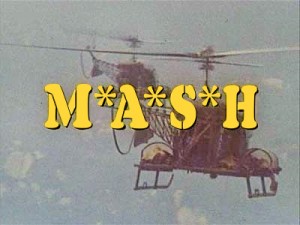 For years many Americans, myself included, were drawn into the Korean War, or at least one aspect of it, in the form of M*A*S*H, a popular television show about the way a Mobile Army Surgical Hospital was run…sort of. The show took on more than just the hospital side, by including a comical side that portrayed the antics of Benjamin Franklin Pierce, aka Hawkeye, and his best friend and co-conspirator, BJ Honeycutt. I can’t say just how true to life the show was, but we all cried right along with the doctors and nurses when they lost a patient, and cheered when they saved one.
For years many Americans, myself included, were drawn into the Korean War, or at least one aspect of it, in the form of M*A*S*H, a popular television show about the way a Mobile Army Surgical Hospital was run…sort of. The show took on more than just the hospital side, by including a comical side that portrayed the antics of Benjamin Franklin Pierce, aka Hawkeye, and his best friend and co-conspirator, BJ Honeycutt. I can’t say just how true to life the show was, but we all cried right along with the doctors and nurses when they lost a patient, and cheered when they saved one.
In reality, the MASH units were a vital part of the war effort, and the saving of  the lives of many soldiers. These were amazing surgeons who learned techniques that cut corners, making surgeries faster and more efficient, bringing lifesaving changes to medicine in the process. The MASH units were originally established in August of 1945, and then were deployed during the Korean War and later conflicts. The Army deactivated the last MASH unit on February 16, 2006, which I did not know, but I’m sure most of my military friends probably did. The MASH units were replaced by the CSH or Combat Support Hospital. I’m sure the CSH units are amazing units too, and maybe someday they will have as big a place in history as the MASH units did, but unless they do a television show that is as popular as the M*A*S*H show was, I don’t think their place in history will be as well known to the American people as the MASH units were. I’m sure that with all the improvements, the CHS units are probably better and more up to date than the MASH units were, but in the hearts of the M*A*S*H fans, the CHS units have big shoes to fill.
the lives of many soldiers. These were amazing surgeons who learned techniques that cut corners, making surgeries faster and more efficient, bringing lifesaving changes to medicine in the process. The MASH units were originally established in August of 1945, and then were deployed during the Korean War and later conflicts. The Army deactivated the last MASH unit on February 16, 2006, which I did not know, but I’m sure most of my military friends probably did. The MASH units were replaced by the CSH or Combat Support Hospital. I’m sure the CSH units are amazing units too, and maybe someday they will have as big a place in history as the MASH units did, but unless they do a television show that is as popular as the M*A*S*H show was, I don’t think their place in history will be as well known to the American people as the MASH units were. I’m sure that with all the improvements, the CHS units are probably better and more up to date than the MASH units were, but in the hearts of the M*A*S*H fans, the CHS units have big shoes to fill.
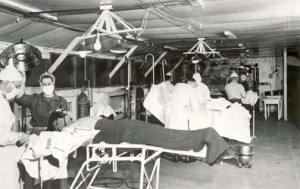 Many an evening has found Bob and I watching a M*A*S*H marathon. And during the original years, we watched it every night that it was on. We simply liked the show. I have to wonder if any other war has been watched as much as the Korean War…even though people didn’t necessarily realize that they were watching a war, or at least a part of it. While we may not have really learned a lot about the Korean War from this source, we did learn something about one part of the war…a vital part in all reality. Now that M*A*S*H is on again as re-runs, we often fine ourselves watching it again…even though we know how it will end. It is just one of those timeless shows. You just really never get tired of them…even the re-runs.
Many an evening has found Bob and I watching a M*A*S*H marathon. And during the original years, we watched it every night that it was on. We simply liked the show. I have to wonder if any other war has been watched as much as the Korean War…even though people didn’t necessarily realize that they were watching a war, or at least a part of it. While we may not have really learned a lot about the Korean War from this source, we did learn something about one part of the war…a vital part in all reality. Now that M*A*S*H is on again as re-runs, we often fine ourselves watching it again…even though we know how it will end. It is just one of those timeless shows. You just really never get tired of them…even the re-runs.

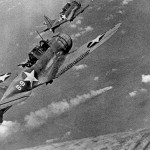 The Japanese navy in 1942 was a power that seemed impossible to beat. They had not lost a battle since their defeat the Battle of Shimonoseki Straits in 1863. It was the goal of the Japanese operation to eliminate the United States as a strategic power in the Pacific…the same reason the attack on Pearl Harbor was important to them. On June 4, 1942, Japanese Admiral Chuichi Nagumo, commander of the fleet that attacked Pearl Harbor, launched a raid on Midway Island with almost the entire Japanese navy. It was to be a decisive battle. Their plan was to make another power grab that that would widen their sphere of influence and conquest. They set their sights on Midway, an island group in the central Pacific, as well as on the Aleutians, off the coast of Alaska. The United States Navy was badly wounded, and the Japanese were determined to finish it off.
The Japanese navy in 1942 was a power that seemed impossible to beat. They had not lost a battle since their defeat the Battle of Shimonoseki Straits in 1863. It was the goal of the Japanese operation to eliminate the United States as a strategic power in the Pacific…the same reason the attack on Pearl Harbor was important to them. On June 4, 1942, Japanese Admiral Chuichi Nagumo, commander of the fleet that attacked Pearl Harbor, launched a raid on Midway Island with almost the entire Japanese navy. It was to be a decisive battle. Their plan was to make another power grab that that would widen their sphere of influence and conquest. They set their sights on Midway, an island group in the central Pacific, as well as on the Aleutians, off the coast of Alaska. The United States Navy was badly wounded, and the Japanese were determined to finish it off.
The Americans were weakened, that was true, but the Japanese sorely misjudged the determination of the American warrior. The Yorktown had been damaged, and there would only be three days to get her repaired and ready for battle. She would be used, along with the Enterprise and the Hornet for this battle. They were all that was left of the aircraft carriers after the attack on Pearl Harbor. The question on the minds of everyone…would it be enough? Only time would tell. And there was no more time. The battle had begun.
The attack came in the morning, on June 4th. Admiral Nagumo wanted to lure the United States aircraft carriers into a trap. He launched his first strike with 108 aircraft…bringing significant damage to the US installations at Midway. The Americans struck back over and over, but accomplished little, losing 65 of their aircraft in those first attempts. The Japanese admiral was sure that his plan had worked. He could almost taste victory, but he had underestimated the tenacity and determination of Admiral Chester Nimitz and Admiral Raymond Spruance, the commanders of the American forces. Admiral Nagumo ordered a second wave of bombers to finish off what he thought was only a remnant of American resistance. This was when he found out just how wrong he had been, and how badly he had misjudged the Americans. The American Admirals had anticipated the attack on Midway, and they managed to conceal their position because of good reconnaissance, which gave them sufficient opportunity to rearm.
The Americans sent in 55 US dive-bombers to take full advantage of Admiral Nagumo’s confusion. He honestly thought this battle would be a simple, but decisive win for the Japanese, but his world came crashing down when the Americans sunk three of the four Japanese carriers, all of them cluttered with aircraft and fuel, ready to launch another attack. The realization came to Admiral Nagumo after it was too late. The Americans had a much larger naval force that he had expected. The Japanese carrier, the Hiryu was crippled, but not before it finished off the American carrier Yorktown.
The attack on Midway was a complete disaster for the Japanese. In all, they lost 322 aircraft and 3,500 men. 
 They were forced to withdraw from the area before even attempting a landing on the island that had been their goal for the attack. Midway was safe, and the Japanese went away with a major lesson learned. The Battle of Midway took place roughly at the middle of World War II, and things went downhill from that point on for the Japanese. They would not win this war, but rather would surrender on September 2, 1945. They took away a new understanding of the American war machine after World War II. The United States was a formidable foe, and one that refused to give up to evil nations.
They were forced to withdraw from the area before even attempting a landing on the island that had been their goal for the attack. Midway was safe, and the Japanese went away with a major lesson learned. The Battle of Midway took place roughly at the middle of World War II, and things went downhill from that point on for the Japanese. They would not win this war, but rather would surrender on September 2, 1945. They took away a new understanding of the American war machine after World War II. The United States was a formidable foe, and one that refused to give up to evil nations.
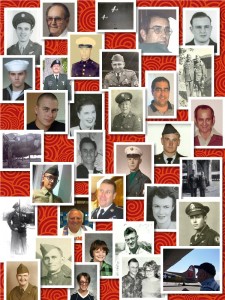 Many men and women have served in the military over the centuries, since the United States became a nation, and in the years that we fought for our independence. The weapons they used are as varied as they are, but no less deadly to the enemy. Their uniforms are different, and some may seem very strange to us, but each is easily recognizable as a military uniform, and you knew that they had served their country. Each has made the sacrifice…leaving loved ones behind at home, to go off and fight in a battle that in many cases didn’t seem like it was their own, yet they had to go, because they couldn’t leave those oppressed people to battle on their own, because they knew it was a battle they could not win alone. They went, because it was a matter of duty. It was a duty they could not ignore…their hearts would not let them ignore.
Many men and women have served in the military over the centuries, since the United States became a nation, and in the years that we fought for our independence. The weapons they used are as varied as they are, but no less deadly to the enemy. Their uniforms are different, and some may seem very strange to us, but each is easily recognizable as a military uniform, and you knew that they had served their country. Each has made the sacrifice…leaving loved ones behind at home, to go off and fight in a battle that in many cases didn’t seem like it was their own, yet they had to go, because they couldn’t leave those oppressed people to battle on their own, because they knew it was a battle they could not win alone. They went, because it was a matter of duty. It was a duty they could not ignore…their hearts would not let them ignore.
Today’s military is not a required job, there is no draft, although there could be if it became necessary, and our young men are required to register for the draft when they turn eighteen, just in case a draft became necessary. Nevertheless, today’s military men and women choose to take on the causes of a war ridden world, because they can’t bear to leave a people or nations unprotected. That takes a special kind of person…that one who puts themselves in harm’s way…by choice. They are a person to be admired and respected. I don’t say that those who do not join have done anything wrong, because they have not, but like the police officer, EMT, and fire fighter, this unique group of men and women have taken up a cause, and made it their own.
My dad, and many of my aunts, uncles, nieces, nephews, in-laws, and cousins fall into that category of military personnel, and I am proud of each and every one of them for all they have done to make this world a little bit safer place. Their sacrifice has not gone unnoticed, nor will it ever be forgotten. Today, I want to thank all veterans everywhere, living and dead, for the sacrifice you have made to give me and all other Americans the freedoms that we enjoy, and to make this world a little bit safer for all the people who live in it. I know I can’t picture all of you, as you so richly deserve, but know that you are remembered, whether you are pictured here or not. Thank you all for your service!! God bless each and every one of you!!

